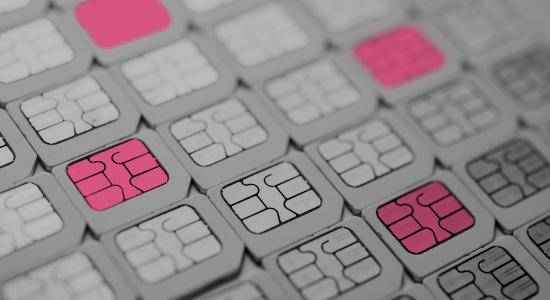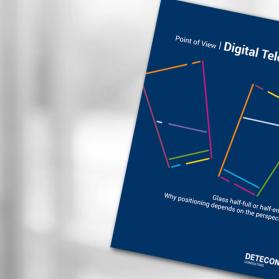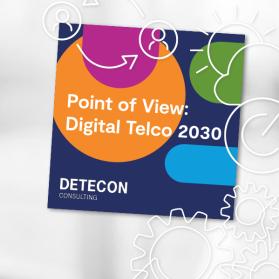Nowadays, innovative products as well as services are no longer sufficient for telcos to overcome the enormous challenges through ongoing changing market environments – customer, competitor and technological vise. The customer and focus on his experience takes the centre stage. Telco companies should address three levers in this context: Gain and use customer insights with methods like personas and customer journey mapping. Boost customer experience by innovative digital technologies like virtual reality, augmented reality (VR/AR) as well as artificial intelligence (AI) and enable modern und unique products, services and touchpoints. Establish the assurance of customer excellence in the organization and protect customers’ voice through a cross-functional responsible department or board. Originating such a customer experience ecosystem based on these levers enables telcos to stay competitive in the long-run.
Cost pressure from falling prices, stagnating sales, the growing competition from OTT providers with their disruptive business models, and the diminishing loyalty of customers are central challenges telcos are confrontated with. Not less than the authentic satisfaction of rational and particularly emotional expectations and needs of customers, at all times and at every touch point during their journey, is a decisive driver make the difference in competition.
How can telcos concretely achieve excellent customer experience on the next level? Which methods, technologies and organizational changes do telcos have to apply to create best customer-focused value to differentiate from competitors?
Create Experience by Understanding your Customer!
Customer centricity implies a deep understanding of customers and their individual needs as well as to implement this mindset into development and adaptation of products, services and touchpoints. It shifts the value chain from product to customer perspective through always starting with the customer himself.
In order to understand the needs of a customer in detail, it is useful to develop the various relevant customer typologies as personas. In this concept a customer or a customer group is not seen as a single mass. It is possible to analyze target groups much more specifically and more detailed than conventional segmentation models do. Typical users of products or services are presented as real persons - in all relevant facets, such as individual CVs, character traits, needs, interests, problems / fears, etc. To work with this approach is like acting as a “profiler”: Essential relevant personality traits and characteristics are identified. The purpose is to uncover the "unknown essence of the customer", and to draw conclusions about his behavior. The customer is presented here as a fictional person (persona) and represents a whole group of consumers with similar characteristics, living environment as well as matching needs. There is a basic personas framework with typical characteristics, which might be followed. Besides name, age, place of residence, profession and material status, it also comprehends character traits, individual needs and interests of a customer, differencing for each industry where it is applied. And – last but not least – it should reveal his digital affinity and channel preferences to meet new innovative distribution channel expectations.
Having fully understand your customers’ needs is essential to reach customer centricity. As a next step, it is mandatory to also understand how customers move inside a company’s ecosystem. With a customer journey telcos can understand all interactions, recognitions and feelings of a customer while using their products and services at any touchpoint.
For deriving a complete customer journey important dimensions as episodes, end-to-end experience, customer’s own “language”, preferred channels, duration and repetition have to be comprised. It uncovers at which touchpoint or at which stage excellent customer experience is realized or whether there are pain points. Identified issues can then be customized and consistently optimized to the desired end-to-end customer experience using customer journey mapping.
Use Technology to Boost your Customers Experience!
With present technological inventions, companies got enabled to boost their productivity and to increase their customer experience by involving more and more digital innovations.
In this context, one well-discussed technology is augmented and virtual reality (AR/VR). AR is applied to create users experiences by extending the real world with some virtual elements that supplement an environment with computer-generated sensory inputs. By using VR companies have the possibility to engage customers like never before and to reinvent their product and service offering at any touchpoint in unique digital way. It offers for example the possibility to develop 3D digital showrooms and sales presentations. Consumers can virtually use the product and therefore they can trust its performance and shown features. A presentation based on VR/AR is visual, technically proficient and can be personalized for each customer. Telco companies are often distributing virtual and intangible products, like mobile and phone tariffs, cloud products, etc. 3D digital showrooms, for example, show customers all benefits of a product and services with a real look and feel. Service activities, as an essential customer touchpoint, can strongly benefit from VR/AR usage. A Swiss telco provider, for example, started to use an AR based Smart Assistance solution to support their field service agents. Some Agents got equipped with special glasses. The glasses provided the agents with information to make their work more efficient and helped them solve complex system problems faster while being on customer’s premises.
There is also great potential to integrate VR and AR technologies into product and service development. With virtual product design, consumers have the ability to test-drive products and service in various stages of development. Virtual product design provides a more simplified and probably less-expensive way of a minimum viable product (MVP) like a virtual prototype. With 360° perspectives and full-features product shows customers can provide companies with detailed feedbacks and impressions without witnessing it in real. In such an innovative development process customers and uses repeatedly interact with the prototypes at every stage of the entire development process.
AI technology is able to shift assist companies in their customer experience creation. It describes a technology that emphasizes the creation of intelligent machines that can work and react like humans. It mostly includes image and speech recognition, learning, planning and problem solving elements. In our customer context, it is now possible to effectively, and accurately, automate customer interactions and predict further customer needs through deep learning and predictive analytics of data. At the same time companies can provide their customers with a more immediate and personalized response to their request.
By implementing AI companies can leverage many customer-related activities like visual search, natural language processing, usage and behavioral analytics. AI algorithms can be used for cross-platform advertising, intelligent e-mail and content-aware video advertising, among others things. With endorsing AI technology telcos can address their customers individually, demand-focused and at the right moment without the need to bring more human capital into it. Especially, telcos need to deal with many service requests. With the help of AI technology human involvement can be reduced without losing service quality while the availability of service offerings extends. Machine learning can help streamline processes, which helps humans to focus on tasks that actually require human input. Right now AI augmented messaging, AI organized email inquiries and AI enhanced customer phone calls are taking over simple serving tasks, so humans can focus on more complex service requests.
Organize Customer Experience!
In our experience, telcos are still not acting consistenly customer-centric due to their organizations and underlying governances. In these days, company segments decide business activities with customer impact in own organizational silos and in the sense of their business interest without bearing in mind the entire organization with all its cross connections. Customer targets are mostly not in focus but rather steering elements consisting of pure efficiency targets, short-oriented revenue improvements or pressure resulting from competition to bring a new product to the market.
In order to encounter this issue, companies need a central unit with cross-functional responsibility for a customer-oriented behavior within their organization. Consequently, such an unit would be in charge for analyzing customer needs, for decisions which measure might be executed based on customer needs as well as for consequent tracking of an effective implementation. From our point of view, the implementation of a customer board orchestrates as well as comprehensively steers all company activities affecting the customer experience as a neutral decision-making committee from customers’ perspectives. As a result, all company activities that influence customer experience need to pass this board.
The mission of this committee is to create transparency regarding companies performance in terms of main customer KPIs (e.g. satisfaction indices or net promoter scores) on a integrated company, product, service and touchpoint level as well as regarding already existing and planned measures throughout the customer journey. Moreover, the customer board should be equipped with a decision and recommendation mandate in order to design diversified, customer-orientated and up-to-date product portfolios. This implies the decision-making authority to release new or adapted offerings for market entry, to eliminate existing offerings from the product portfolio, to prioritize necessary changes and new product requests and thus to define central customer segments for marketing and sales.
However, telcos need to consider some basic principles for a successful implementation of a corporate customer board. One major success factor is the consideration of customer KPIs inside companies overall steering logic as well as in individual targets of all relevant units and decision-makers. Moreover, the customer board should be positioned on a comprehensive level in the organization of telcos. It is common to allocate the customer board directly below the executive board level and to integrate executives in order to strengthen the board’s position and acceptance. Only with organizational autonomy, the customer board is able to function independently from traditional business unit objectives and to take decision over products, services and touchpoints beyond business silos but considering customers’ perspectives.
In addition, the customer board should assume responsibility for and decide over all existing product units. This allows on the one hand the already mentioned creation of transparency regarding planned measures. On the other hand, it enables to break up silo thinking in the organization. Thus, the customer board possess a comprehensive view on the product portfolio and is able to define as well as to prioritize implementation decisions based on the overall business strategy. Against this backdrop, it might also make sense to equip the customer board with a decision mandate regarding the corresponding allocation of financial and human capital in order to invest company resources throughout the entire organization reasonably along customer needs. The board should consist of all representatives with voting rights from every product unit. In addition, important representatives from units with customer contact (for example sales, customer care, administration of customer-relevant processes) and from a central customer unit should be considered.
In case of the task allocation, our experience shows two different implementation options for a customer board. Consequently, it is one option to implement one customer board solely for decision-making over development and adaption of product, services and touchpoints. A second option is to implement three customer boards based on the described decisions. Although especially option two results in additional complexity of an already challenging idea, it is a valuable concept to share and divide decision-making power within the organization. Moreover, it aims to reduce the perception that too much power and control is allocated to an already newly introduced committee.
Briefly, the customer board completes the persona and customer journey concept to create as well as the technologies AR/VR and AI to boost customer experience and consequently builds the organizational fundament.
Create a Customer Experience Ecosystem!
All three dimensions exemplified before are providing a structure to enable a customer experience ecosystem into a company’s organization. By focusing on approaching customer centricity into development and the organization itself companies are enabled to better understand their customer demands and expectation. Companies have the opportunity to provide customers a unique and digital experience as nowadays expected, by combining customer centricity with innovative technologies at any customer touchpoint. Moreover, new innovative trends present opportunities to provide customers with unique experiences, therefore to differentiate from competitors. The establishment of a customer board builds a fundament for telcos to overcome organizational barriers and to fulfill every activity to deliver excellent customer experience. After all, companies have to adapt all three levers together to build an effective customer oriented value chain in their own ecosystem. By managing the customer experience from end-to-end telcos are able to make the difference in market and stay competitive in the long run.








